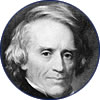Samuel F. B. Morse
1791–1872 B.A. 1810
|

|
Samuel F. B. Morse was nearly 53 when his most famous invention received official recognition and financial backing, and it couldn’t have come at a better time. On the last day of the Senate session in March 1843, as he waited against the odds for the vote that could finance a test of his telegraph, Morse’s resources had dwindled to train fare home and a balance of 37 1/2 cents.
His career as an artist had ground to a halt six years earlier when Congress turned down his bid to decorate the Capitol rotunda. Other large-scale works had found no takers, and not even his portraits of President Monroe and Lafayette did much for his career. Morse had plodded on as the first professor of art in the country (at New York University), the president of the American Academy of Graphic Design, and a sometime journalist and photographer, with an interest in technological novelties like the daguerreotype. In 1836 he even tried politics, but lost the mayoral race in New York (on the Nativist ticket).
Morse had been fascinated by lectures on electricity by Professors Day and Silliman while at Yale. But it was a conversation with shipboard acquaintances in 1832 that inspired the idea of the telegraph. Others in the United States and abroad had entertained similar ideas, however, and competition would remain a problem. After years of demonstrating his machine in Europe and America, Morse conducted the now-famous test between Baltimore and Washington in 1844. The results were patents and wealth.

